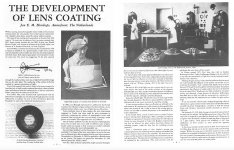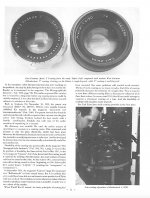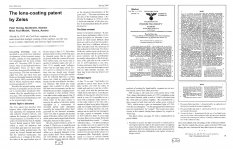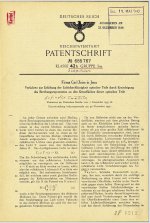John A Roberts
Well-known member

Recently I’ve found three older articles on lens coatings. Each provides a lot of information,
including some that challenges conventional views as to when discoveries were made and coatings introduced
Rather than attempting to summarise each in detail, I’ve instead highlighted points that I thought were of particular interest
A) ‘The Development Of Lens Coatings’ by Jan Bisschops
It’s from the Autumn 1989 issue of the Zeiss Historica Society journal at: https://www.mikeeckman.com/2019/11/zeiss-historica-fall-1989/
As the title indicates, it provides an historical overview of lens coatings
And in relation to the favourably altered reflection qualities of weathered glass noted by Taylor in the 1890’s, there is also a passing reference to Josef von Fraunhofer
In this regard, it’s interesting to note Binastro’s recent observation about Fraunhofer’s use of sulphuric acid in 1817 to deliberately produce the same effect
see posts #4 and 6 at: https://www.birdforum.net/showthread.php?t=383467
(the only mention that I could find on-line is in chapter 1 of ‘Coatings on Glass’ by H.K. Pulker. Pulker’s source is an 1888 collection of Fraunhofer’s writings)
B) ‘The lens-coating patent by Zeiss’ by Peter Hennig and Milos Paul Mladek
It’s from the Spring 2004 issue of the ZHS journal at: https://www.mikeeckman.com/2019/11/zeiss-historica-spring-2004/
It provides details about Zeiss' 1935 German patent for lens coating based on the work of Smakula and his colleagues
The patent specifically addresses the possibility of applying more than one layer - including multiple layers - to a lens surface
I’ve also attached a clear copy of the front page of the patent (the link is too long to post in Bird Forum without it being automatically truncated!)
C) ’T* Multi-Layer Anti-Reflection Coating’
It’s from the 1975 Zeiss West Germany catalogue for 35mm SLR Contax/ Yaschica mount lenses at: http://evtifeev.com/wp-content/files/manual/zeissoptics1975.pdf
It indicates that the first successful double coating of a lens surface was accomplished by the Schott company in 1939, and the first triple coating in 1943
It notes that multi-layer coating was first used in the US aerospace industry in the early 1960’s
(this seems to be an oblique reference to use on the camera lenses of reconnaissance aircraft and satellites)
The work was done by Optical Coating Laboratory Inc. (OCLI), in association with Optics Balzers AG of Liechtenstein
(I’ve previously provided detail about the early commercial use by Swarovski of coatings developed by Balzers
- double layer coatings in 1948, and triple layer coatings in 1967; see posts #18 and 32 at: https://www.birdforum.net/showthread.php?t=371675 )
It also notes in relation to Zeiss that:
- in the mid-1960’s, three and more layer multi-coating was introduced on some microscopes, and
- in 1972, multi-coating which was from then on identified as T* coating (verses single layer T coating), was introduced on photographic lenses
In contrast, T* coating was not introduced on binoculars until 1978
- - - -
So in relation to multi-coating (i.e. where a minimum of three layers is used):
- by 1943, Schott had experimentally succeeded in applying three layers to a lens surface
- by the early 1960’s, there was industrial use by OCLI
- by the mid 1960’s, there was commercial use by Zeiss West Germany on some microscopes (including more than three layers)
- by 1967, Swarovski was using it on their AZF telescopes (as explained in my link to Optics Balzers), and
- by 1972, Zeiss West Germany had introduced it on photographic lenses
Keep in mind that just because one or more lens surfaces of a device were multi-coated, that did not mean that all the lens surfaces were so coated
i.e. the distinction at the time between between ‘multi-coated’ verses ‘fully multi-coated’
- - - -
And it seems that the multi-coating of camera lenses predates the introduction by Zeiss, see: http://www.aohc.it/testi.php?id_testi=59
While Pentax (then Asahi Optical Company) is often credited as having introduced multi-coated camera lenses in 1971,
at the time Nikon claimed to have already been using three and four layer coatings
And while Pentax claimed to apply up to seven layers using conventional vapour deposition, that was disputed by other manufacturers as not being technically possible
(additionally, it seems that Pentax hadn't developed its technology from scratch but had purchased OCLI’s patents)
More remarkably, Fuji claimed that using its electron-beam coating technology, to have applied up to 11 layers on special movie camera lenses made for the 1964 Olympics in Tokyo!
John
p.s. Commercial use of double layer coatings:
• As per my previous link, Swarovski commenced new binocular production in April 1948. And well before the end of the year they were using Optics Balzers' double layer coating
This implies that Balzers had perfected the commercial production process sometime prior to this - the company been established in 1946
(The Allies only allowed production of optical devices to recommence in Austria and Germany in 1948. In contrast, Swarovski recommenced production of spectacle lens blanks in late 1945)
• In C) above, it’s indicated that sometime after 1945, the new Zeiss West Germany also commenced to use double layer coatings
However, this was on some camera lenses and especially on camera lens filters. So particularly in relation to the former, that would have been at the earliest from 1948
including some that challenges conventional views as to when discoveries were made and coatings introduced
Rather than attempting to summarise each in detail, I’ve instead highlighted points that I thought were of particular interest
A) ‘The Development Of Lens Coatings’ by Jan Bisschops
It’s from the Autumn 1989 issue of the Zeiss Historica Society journal at: https://www.mikeeckman.com/2019/11/zeiss-historica-fall-1989/
As the title indicates, it provides an historical overview of lens coatings
And in relation to the favourably altered reflection qualities of weathered glass noted by Taylor in the 1890’s, there is also a passing reference to Josef von Fraunhofer
In this regard, it’s interesting to note Binastro’s recent observation about Fraunhofer’s use of sulphuric acid in 1817 to deliberately produce the same effect
see posts #4 and 6 at: https://www.birdforum.net/showthread.php?t=383467
(the only mention that I could find on-line is in chapter 1 of ‘Coatings on Glass’ by H.K. Pulker. Pulker’s source is an 1888 collection of Fraunhofer’s writings)
B) ‘The lens-coating patent by Zeiss’ by Peter Hennig and Milos Paul Mladek
It’s from the Spring 2004 issue of the ZHS journal at: https://www.mikeeckman.com/2019/11/zeiss-historica-spring-2004/
It provides details about Zeiss' 1935 German patent for lens coating based on the work of Smakula and his colleagues
The patent specifically addresses the possibility of applying more than one layer - including multiple layers - to a lens surface
I’ve also attached a clear copy of the front page of the patent (the link is too long to post in Bird Forum without it being automatically truncated!)
C) ’T* Multi-Layer Anti-Reflection Coating’
It’s from the 1975 Zeiss West Germany catalogue for 35mm SLR Contax/ Yaschica mount lenses at: http://evtifeev.com/wp-content/files/manual/zeissoptics1975.pdf
It indicates that the first successful double coating of a lens surface was accomplished by the Schott company in 1939, and the first triple coating in 1943
It notes that multi-layer coating was first used in the US aerospace industry in the early 1960’s
(this seems to be an oblique reference to use on the camera lenses of reconnaissance aircraft and satellites)
The work was done by Optical Coating Laboratory Inc. (OCLI), in association with Optics Balzers AG of Liechtenstein
(I’ve previously provided detail about the early commercial use by Swarovski of coatings developed by Balzers
- double layer coatings in 1948, and triple layer coatings in 1967; see posts #18 and 32 at: https://www.birdforum.net/showthread.php?t=371675 )
It also notes in relation to Zeiss that:
- in the mid-1960’s, three and more layer multi-coating was introduced on some microscopes, and
- in 1972, multi-coating which was from then on identified as T* coating (verses single layer T coating), was introduced on photographic lenses
In contrast, T* coating was not introduced on binoculars until 1978
- - - -
So in relation to multi-coating (i.e. where a minimum of three layers is used):
- by 1943, Schott had experimentally succeeded in applying three layers to a lens surface
- by the early 1960’s, there was industrial use by OCLI
- by the mid 1960’s, there was commercial use by Zeiss West Germany on some microscopes (including more than three layers)
- by 1967, Swarovski was using it on their AZF telescopes (as explained in my link to Optics Balzers), and
- by 1972, Zeiss West Germany had introduced it on photographic lenses
Keep in mind that just because one or more lens surfaces of a device were multi-coated, that did not mean that all the lens surfaces were so coated
i.e. the distinction at the time between between ‘multi-coated’ verses ‘fully multi-coated’
- - - -
And it seems that the multi-coating of camera lenses predates the introduction by Zeiss, see: http://www.aohc.it/testi.php?id_testi=59
While Pentax (then Asahi Optical Company) is often credited as having introduced multi-coated camera lenses in 1971,
at the time Nikon claimed to have already been using three and four layer coatings
And while Pentax claimed to apply up to seven layers using conventional vapour deposition, that was disputed by other manufacturers as not being technically possible
(additionally, it seems that Pentax hadn't developed its technology from scratch but had purchased OCLI’s patents)
More remarkably, Fuji claimed that using its electron-beam coating technology, to have applied up to 11 layers on special movie camera lenses made for the 1964 Olympics in Tokyo!
John
p.s. Commercial use of double layer coatings:
• As per my previous link, Swarovski commenced new binocular production in April 1948. And well before the end of the year they were using Optics Balzers' double layer coating
This implies that Balzers had perfected the commercial production process sometime prior to this - the company been established in 1946
(The Allies only allowed production of optical devices to recommence in Austria and Germany in 1948. In contrast, Swarovski recommenced production of spectacle lens blanks in late 1945)
• In C) above, it’s indicated that sometime after 1945, the new Zeiss West Germany also commenced to use double layer coatings
However, this was on some camera lenses and especially on camera lens filters. So particularly in relation to the former, that would have been at the earliest from 1948
Attachments
Last edited:









